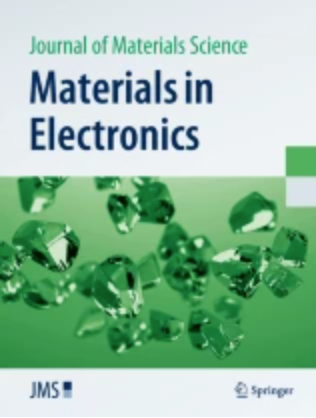摘要
这项研究探讨了用传统固态反应技术制备的 BaMnO3 和 Ba0.9Sr0.1MnO3 多铁素体陶瓷的结构、光学和随温度变化的介电性能。XRD 分析表明 BaMnO3 具有斜方体包晶结构。当 BaMnO3 基体中加入 10 重量%的 Sr 与 Ba 相对时,斜方体结构转变为六方包晶体结构。BaMnO3 和 Ba0.9Sr0.1MnO3 的平均晶体尺寸分别为 ~ 92 nm 和 ~ 63 nm。在纯 BaMnO3 中,晶格参数和单胞体积也随着 Sr 的加入而减小。通过 EDX 分析,验证了最终样品中所有成分的存在。BaMnO3 的光带隙从 2.33 eV 减小到 1.75 eV,这主要归因于 SrMnO3 相和晶界效应。在 BaMnO3 中掺入 10 wt.%的锶后,介电常数在 200 °C、10 Hz 频率下达到了更高的值,即 ~ 19,800,这可能会提高由介电材料制成的电子设备的效率。阻抗分析证实了样品的负温度系数电阻(NTCR)特性,而半圆弧奈奎斯特图则证明了这两种样品都具有非德拜弛豫机制的半导体性质。

This work probes the structural, optical and temperature-dependent dielectric properties of BaMnO3 and Ba0.9Sr0.1MnO3multiferroic ceramics prepared by conventional solid state reaction technique. XRD analysis indicates rhombohedral perovskite structure of BaMnO3. When 10 wt.% Sr is added in the BaMnO3 matrix against Ba, the rhombohedral structure transforms into hexagonal perovskite structure. The average crystallite size of BaMnO3 and Ba0.9Sr0.1MnO3were found to be ~ 92 nm and ~ 63 nm, respectively. The lattice parameter and the unit cell volume also decrease with the addition of Sr in pure BaMnO3. Through EDX analysis, the presence of all the constituents in the final samples are verified. The optical band gap of BaMnO3 decreases from 2.33 eV to 1.75 eV, primarily attributed to SrMnO3 phase and grain boundary effects. A much higher value of dielectric constant i.e. ~ 19,800 at 200 °C with respect to 10 Hz frequency has been achieved with 10 wt.% strontium doping in BaMnO3, which may boost the efficiency of electronic devices made up of dielectric materials. The impedance analysis confirms the negative temperature coefficient of resistance (NTCR) behaviour of the sample and semicircular arc Nyquist plot supports the semiconducting nature with non-Debye type of relaxation mechanism in both the samples.

 求助内容:
求助内容: 应助结果提醒方式:
应助结果提醒方式:


